WHAT IF URBAN TREES COULD
TEXT A WARNING
BEFORE
DANGER BREWED?
Smart‑Band for City Trees that Knocks, Listens and Learns
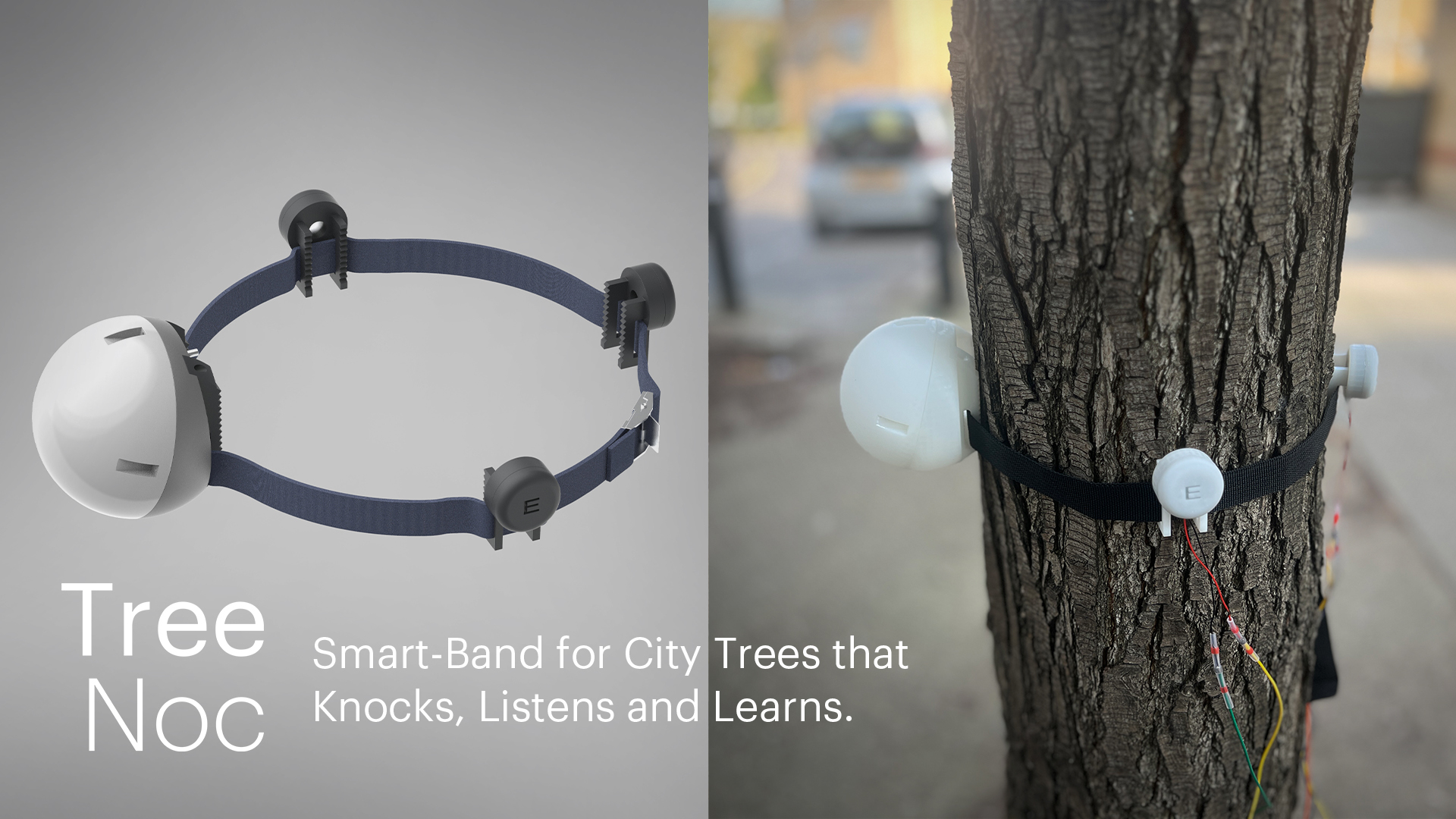
TreeNoc is a novel device designed to continuously monitor the internal health of trees and provide early warnings of potential failures. Shaped like a belt or wristband around the trunk, it uses gentle sound impulses and sensors to detect internal decay, cavities, or stress long before any visible signs appear on the outside. This always-on system streams concise data over low-power networks, alerting tree managers and city councils in real time so that they can intervene early—pruning branches, adding support, or treating diseases—well before a tree becomes dangerously weak.
1. Problem - Rising Tree Threats
The combination of escalating threats and climate change means we can’t wait. UK experts warn that our woodlands are “more vulnerable” than ever. Government climate reports emphasize that warming winters and hotter, drier summers will continue to amplify tree pathogens and pest outbreaks.
UK trees are under unprecedented pressure from climate change and invasive pests. Recent studies warn that tree health risks have surged: sapling mortality in ancient woods has jumped ~90% since 2000 (5-year survival fell from ~41% to ~16%) street trees look healthy until the moment a branch crashes onto a pavement.
Visual checks miss hidden rot; expert sonic scans arrive too late and cost hundreds of pounds per tree.
Climate change, ash dieback and bark beetles intensify the risk, yet councils must stretch shrinking budgets across millions of stems.
UK trees are under unprecedented pressure from climate change and invasive pests. Recent studies warn that tree health risks have surged: sapling mortality in ancient woods has jumped ~90% since 2000 (5-year survival fell from ~41% to ~16%) street trees look healthy until the moment a branch crashes onto a pavement.
Visual checks miss hidden rot; expert sonic scans arrive too late and cost hundreds of pounds per tree.
Climate change, ash dieback and bark beetles intensify the risk, yet councils must stretch shrinking budgets across millions of stems.

Falling tree narrowly misses pedestrians at London crossroads (left, The Telegraph), Tree suddenly falls just in front of driver (right)
One posterchild is ash dieback (Hymenoscyphus fraxineus), a fungal blight of Europe’s native ash. Oxford researchers estimate ash dieback will cost UK society roughly £15 billion (half of that in the next 10 years), and could kill about 95–99% of ash trees.
One posterchild is ash dieback (Hymenoscyphus fraxineus), a fungal blight of Europe’s native ash. Oxford researchers estimate ash dieback will cost UK society roughly £15 billion (half of that in the next 10 years), and could kill about 95–99% of ash trees.

New pests are arriving too – on average one new tree pest or disease establishes in Britain each year – putting the long-term growth of UK woodlands at stake (over half of future growth could be lost to pests by 2050).
These trends show UK woodlands are reaching a critical tipping point: hotter, drier summers and milder winters let pests thrive, while storms and droughts stress already-weakened trees. Yet historically tree diseases were underappreciated: as Dr. Louise Hill (Oxford) notes, society “really hadn’t fully appreciated” the impacts of tree pests until these staggering costs were tallied.
In short, British trees now face far greater risks than a decade ago, and urgent action is needed to avoid ecological and economic collapse.
2. The Invisible Enemy: Why Early Detection is Hard
Part of the problem is that many tree diseases develop inside the wood, invisible from outside. Ash dieback fungus, for example, spreads via windborne spores that penetrate leaf stalks and grow internally, eventually blocking the tree’s water transport system. By the time leaves wilt and bark lesions appear, the infection is deep inside the branches. The photo below shows the brown necrosis that forms inside an ash limb killed by dieback – damage that is hidden until the wood is cut open.

This invisibility is common: invasive insects like emerald ash borer (not yet in the UK) only show up about a year after they infest a tree, when thin “D”-shaped holes or crown dieback appear. In general, many fungal or insect threats lurk under bark or inside the trunk, eluding casual inspection.
By the time foresters spot a sick tree, it can be beyond saving. Thus, relying on human surveys alone means critical early warning signs are missed.
3. Conventional Sonic Tomography: Opportunity and Limitations
Sonic or acoustic tomography is currently the gold‑standard tool when arborists need to “look inside” a trunk. Up to 24 sensors are pinned around the stem and a hammer strike sends a stress‑wave whose transit times produce an MRI‑like tomogram that highlights cavities, cracks and low‑density rot.
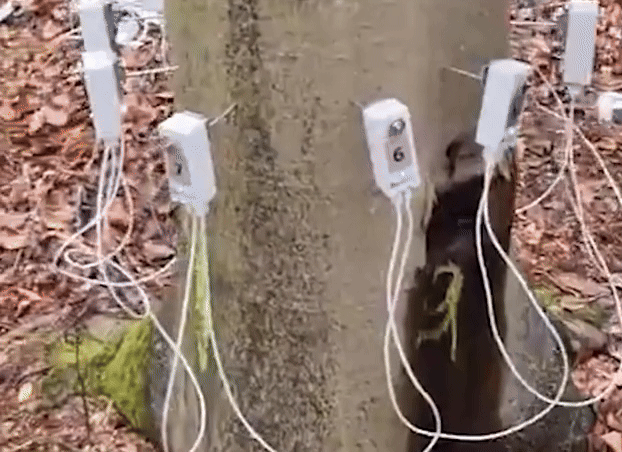
Because set‑up involves attaching and calibrating a dozen probes, the process is slow (30–60 minutes), so most councils commission tomography only after visible symptoms appear or on heritage specimens slated for felling. Each inspection offers a snapshot in time; decay can progress unnoticed for the remaining 364 days until the next survey.
Finally, readings demand specialist interpretation, meaning boroughs must hire external consultants rather than use in‑house staff.
4. Enter TreeNoc – Continuous Insight at Sensor

TreeNoc is a belt‑shaped “digital stethoscope.” A palm‑sized knock module delivers a soft pulse; three listening pods measure how the wave moves through the trunk. Travel time, damping and tonal shifts reveal internal cavities, moisture stress and early pest activity.
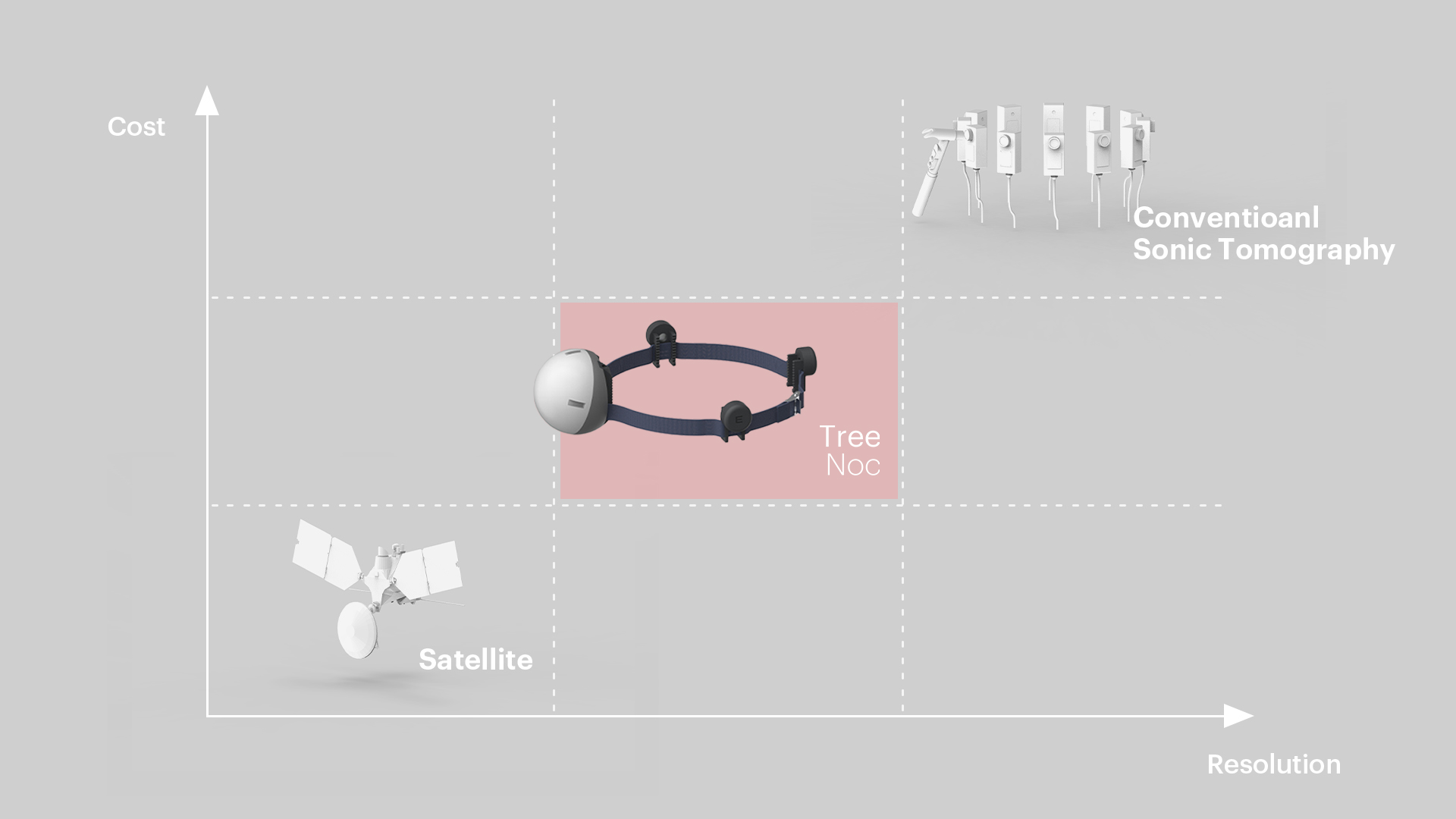
TreeNoc wraps around a tree’s trunk like a flexible belt. It consists of four small pods positioned at equal intervals, forming a ring. On the south-facing side of the ring is a “knock” module about the size of a fist, which generates a gentle, controlled tap on the wood at regular intervals. The other three pods—placed on the north, east, and west sides of the trunk—act as listening sensors. Every time the knock module taps, these sensors pick up the resulting sound wave as it travels through the tree’s stem.
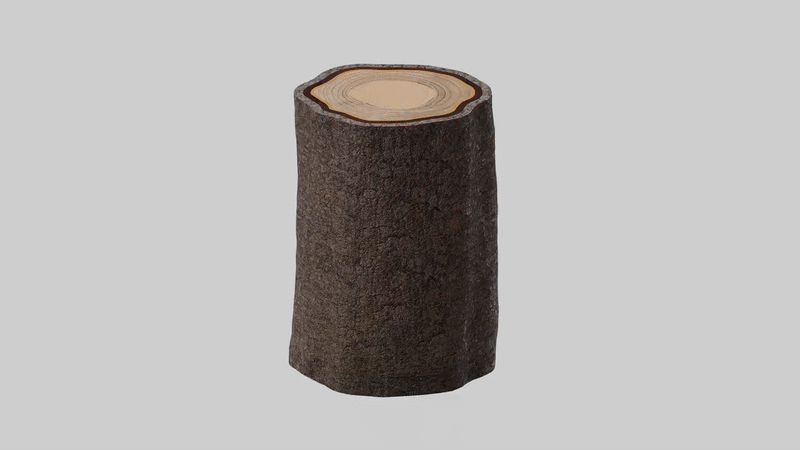
The device measures how quickly and strongly the sound wave travels between the knock point and each sensor. Each tap produces a tiny packet of data that includes the travel time of the sound, the energy lost as it passed through the wood, and any subtle changes in tone of the echo. This information reveals a lot about the tree’s internal condition. For example, a fast and clear echo means the wood fibers are solid and the sap is flowing well. If the sound arrives late, is weak, or the tone is muffled, it could indicate internal problems like hidden hollows, dry and stressed wood from drought, tunnels made by insect infestations, or early stages of fungal decay inside the trunk.
Edge firmware compresses each tap into a few bytes and streams the change, not the raw bulk, over LPWAN. A phone app renders the cross‑section as a colour map: green = sound, yellow = stressed, red = urgent.
Edge firmware compresses each tap into a few bytes and streams the change, not the raw bulk, over LPWAN. A phone app renders the cross‑section as a colour map: green = sound, yellow = stressed, red = urgent.
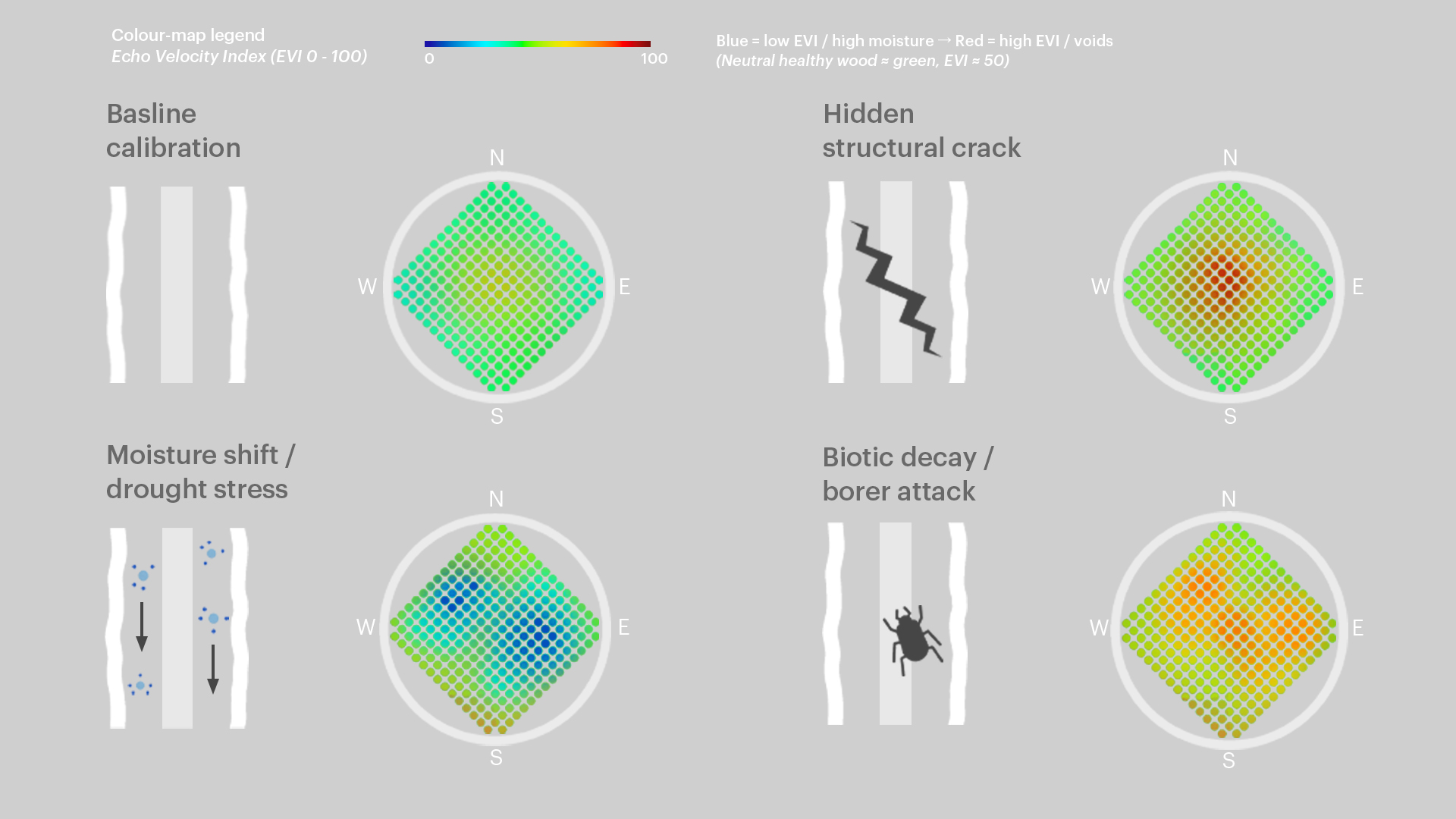
A lightweight machine‑learning model, trained during the early days, treats that tree’s own echo as its baseline; any significant drift triggers a status update. Results appear on the app as an intuitive colour map of the trunk cross‑section—green for sound wood, yellow for emerging stress, red for urgent risk—allowing caretakers to prune, brace or irrigate long before failure strikes.
5. Sound Analysis and Real-Time Alerts
TreeNoc processes the sensor readings on the device itself with minimal delay. Its built-in firmware quickly analyzes each sound pulse and compresses the results into just a few bytes of data. Rather than sending raw audio or large datasets, it sends only the key metrics wirelessly over a low-power wide-area network (LPWAN). This efficient data transmission means that even with limited bandwidth, TreeNoc can continuously stream updates without draining its battery or clogging the network.
![]()
A tiny machine-learning model running on the device learns the tree’s normal “sound fingerprint” within the first couple of days after installation. This model establishes a baseline of how the healthy tree should sound. Once this baseline is set, TreeNoc continuously watches for any significant changes (deltas) from that normal pattern. If it detects a meaningful shift in travel time, energy loss, or tone, the device flags it and immediately sends an alert update.
All the readings over time are visualized in a simple color-coded map on a connected app. The app displays a cross-section of the trunk, with green areas indicating solid, healthy wood, yellow showing early signs of stress or minor changes, and red highlighting serious internal issues or risks. This intuitive visual alert system allows arborists and tree care professionals to take action—like pruning, bracing, or watering—long before the tree is in danger of structural failure.

A tiny machine-learning model running on the device learns the tree’s normal “sound fingerprint” within the first couple of days after installation. This model establishes a baseline of how the healthy tree should sound. Once this baseline is set, TreeNoc continuously watches for any significant changes (deltas) from that normal pattern. If it detects a meaningful shift in travel time, energy loss, or tone, the device flags it and immediately sends an alert update.
All the readings over time are visualized in a simple color-coded map on a connected app. The app displays a cross-section of the trunk, with green areas indicating solid, healthy wood, yellow showing early signs of stress or minor changes, and red highlighting serious internal issues or risks. This intuitive visual alert system allows arborists and tree care professionals to take action—like pruning, bracing, or watering—long before the tree is in danger of structural failure.
“How to use it?”
Step 1 - Add tree in app
Enter species, DBH and height.
![]()
![]()
![]()
![]()
Device learns the tree’s normal pattern.
![]()
![]()

Step 2 - Insert guide pins
Drive nails to the orange line.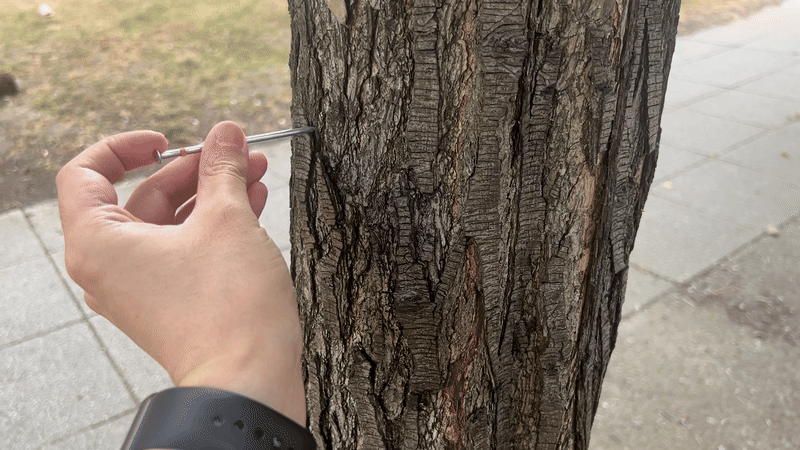
Step 3 - Fit TreeNoc band
Latch the belt round the trunk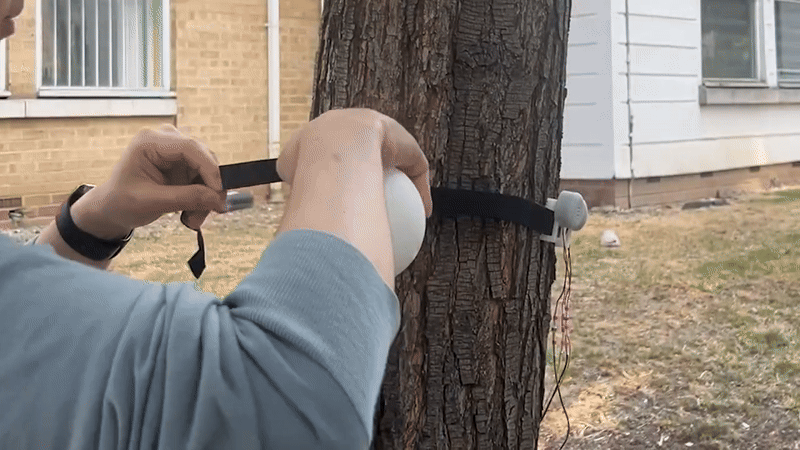
Step 4 - Press start
TreeNoc knocks and listens.
Step 5 - Build baseline
Device learns the tree’s normal pattern.
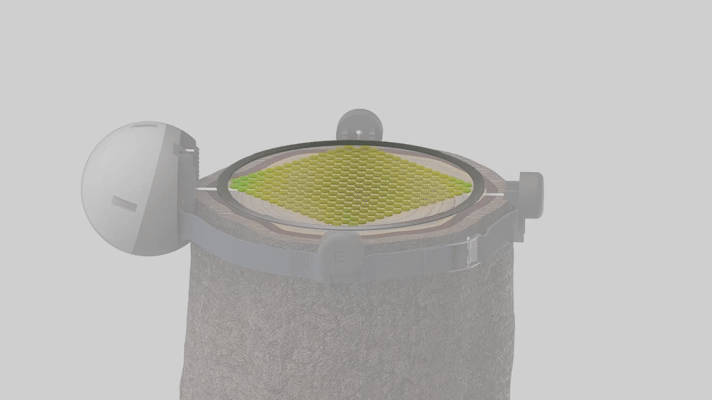
Step 6 - Monitor anywhere
Mobile app flags anomalies in real time.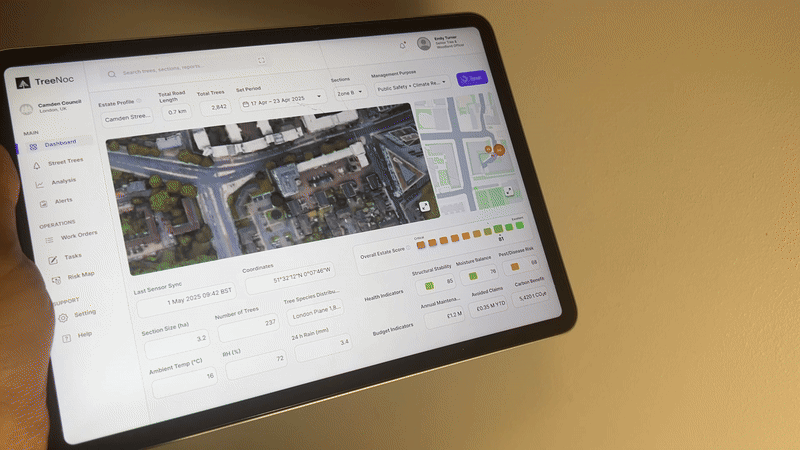
6. Simulation and Testing for Internal Fault Detection
To better understand how sound waves behave in a variety of tree conditions, the developers turned to both computer simulations and physical modeling. They created a virtual tree trunk model using standard wood property data from the USDA Wood Handbook to simulate how sound travels through healthy versus decayed wood. Then, to validate these simulations in the real world, they built physical test logs with artificial defects. For example, they poured melted wax into sections of wood to mimic dense, solid heartwood, and inserted pieces of soft cork to represent decayed or hollow areas within the trunk.
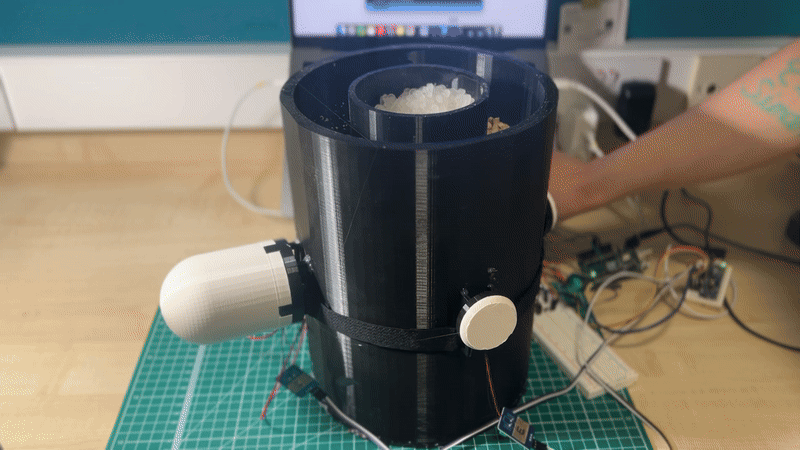
By changing the size and position of these wax and cork inserts, the team was able to produce many scenarios of internal tree damage and measure how TreeNoc’s sensors responded to each one. Each configuration created a distinct pattern of sound speeds and energy losses at the different sensor nodes. These tests confirmed that the multi-sensor approach could indeed identify the presence and location of hidden weaknesses. Moreover, the data collected from numerous scenarios helped train and refine the device’s machine-learning model. With a larger library of sound profiles for various types of internal faults, TreeNoc’s algorithms became better at classifying what kind of problem might be inside (for instance, distinguishing a waterless drought-stressed section from a rot-filled cavity) based on the pattern of echoes detected.
7. Development and Iterations of the Design
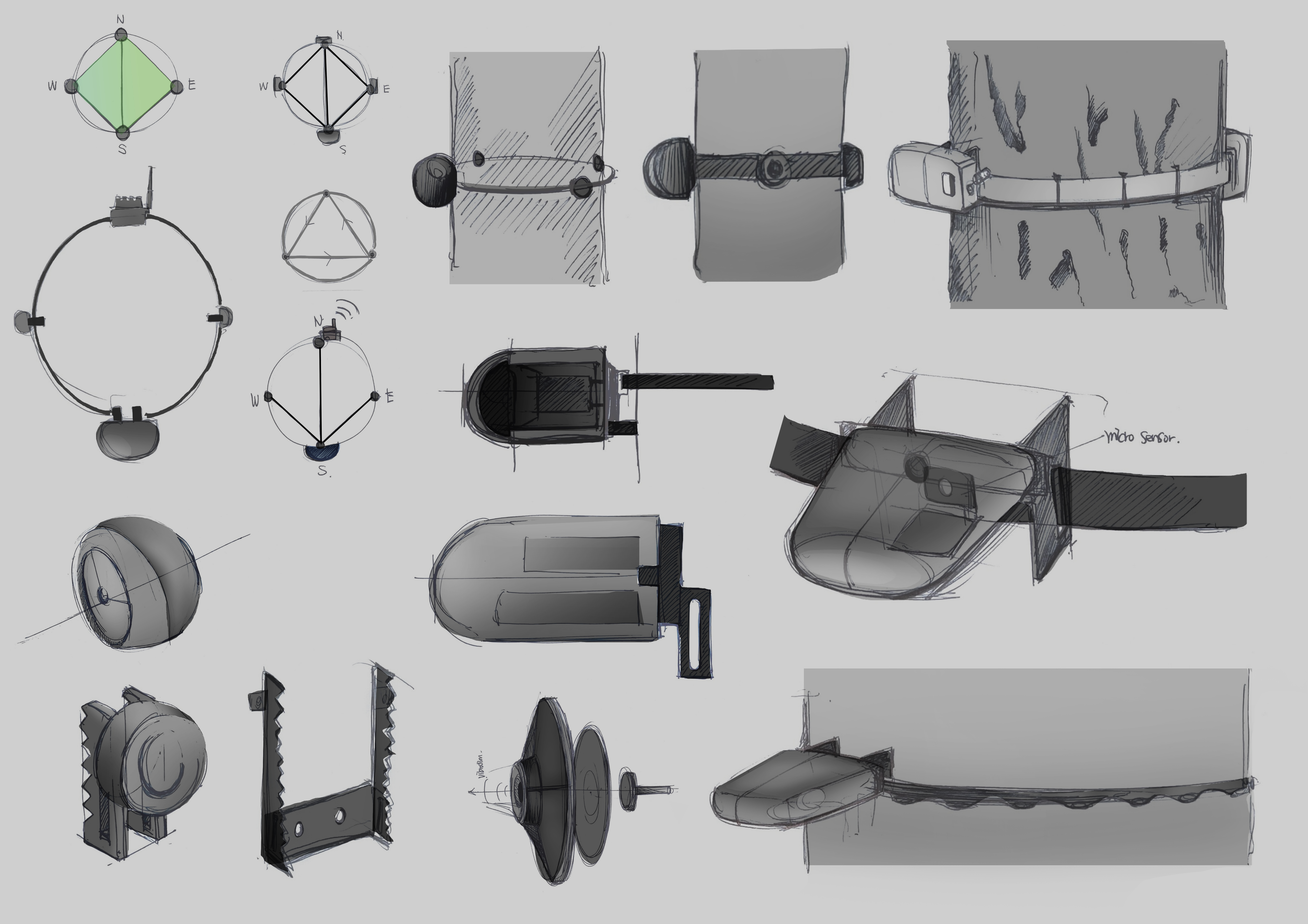
TreeNoc’s design has gone through many prototypes—sixteen full iterations—to reach its current form. The earliest version was very simple: it had a sensor that delivered a knock on one side of a log and a single receiver on the opposite side. In tests, this early rig involved striking a log with a hammer on the south side and measuring how long it took for the sound to reach a sensor on the north side. While this straight-line test could roughly indicate wood density in a simple rectangular wooden beam, it wasn’t good enough for real trees. A tree trunk is round, and internal decay might not lie directly between two opposite points, so a single-path measurement could easily miss pockets of rot off to the side.
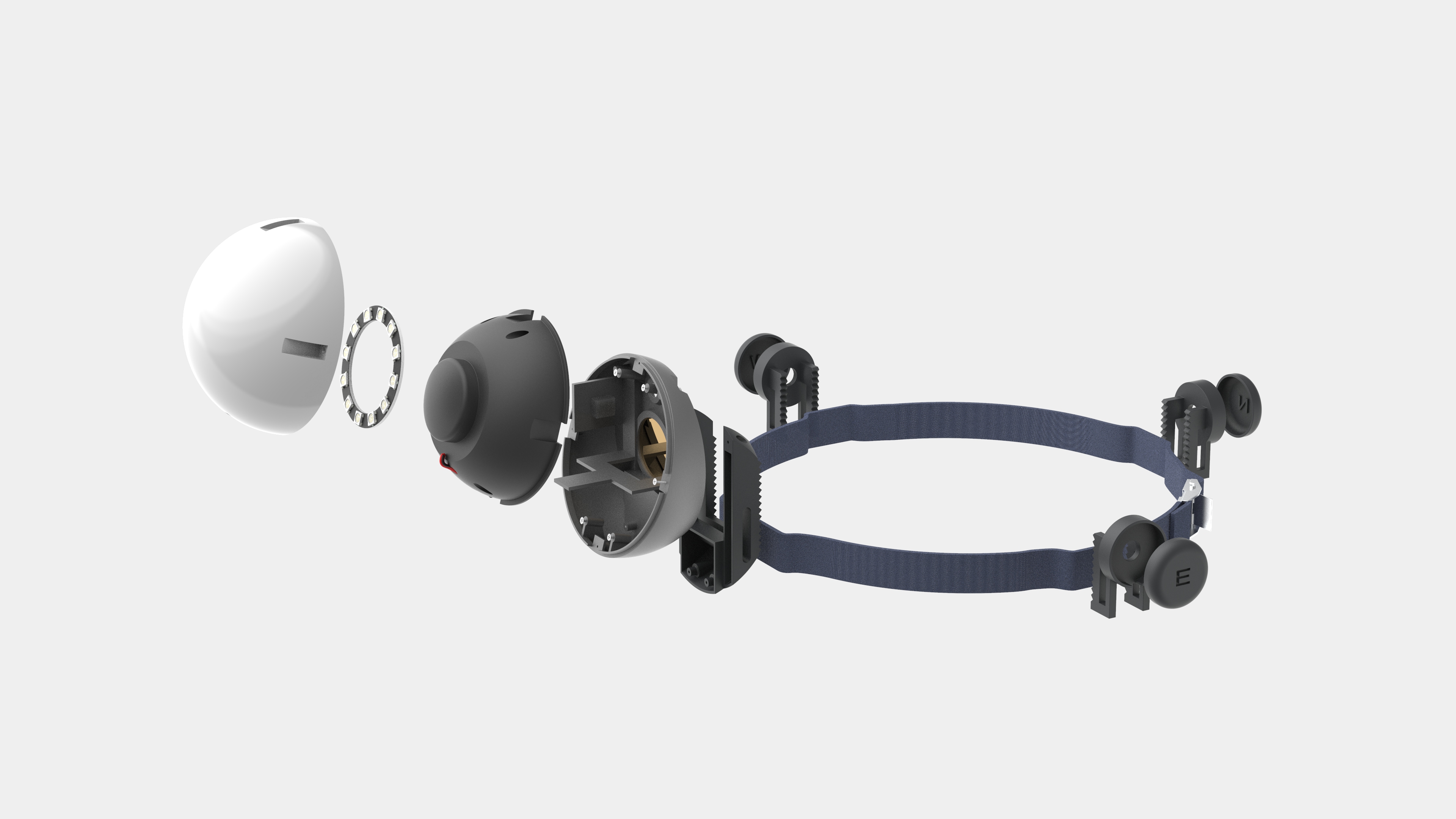
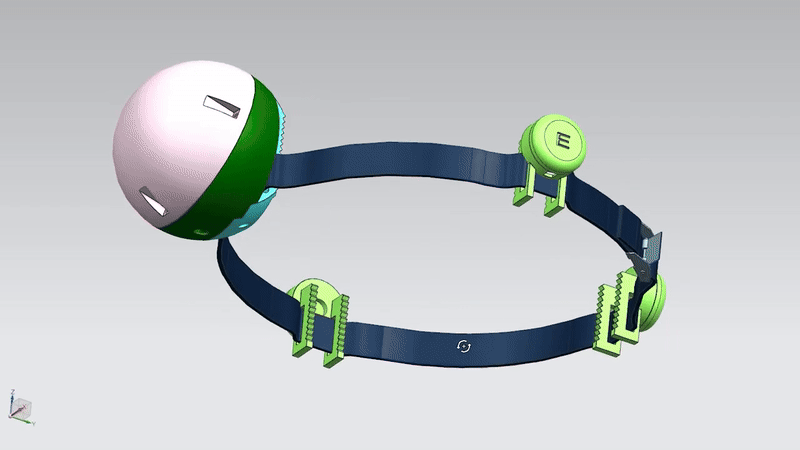
To get a more complete picture of a tree’s interior, the design evolved to include more sensors. A setup with three nodes in a triangular arrangement around the trunk was tested next. However, this triangular layout still had a “blind spot” directly opposite the knock point. If a cavity or damage inside the tree lay in that blind area (between the sensor positions), the three-node system might not detect it reliably. It became clear that four points of measurement were the minimum needed to cover the full circle of the trunk. The team moved to a four-node “diamond” configuration (essentially one sensor on each cardinal direction: north, south, east, and west). With this arrangement, TreeNoc could successfully detect internal weaknesses no matter where they were hiding in the cross-section.
8. Field Testing and Refinement through Feedback
Over the course of a year, prototypes of TreeNoc were shared with professional arborists, reforestation non-profits, and municipal tree officers (such as those in London’s city council). These field experts tried out the device in real-world conditions and provided valuable feedback. Through their observations, the design was refined to be more practical and robust. For instance, one challenge was weather: rainwater and snow could accumulate on the device. In response, the knock module’s housing was redesigned into a spherical shape about 9 centimeters across, which naturally sheds water, snow, and dust so that moisture doesn’t pool on any flat surface.
The feedback also highlighted that the device needed a very secure grip on the trunk to work year-round. The band that clamps around the bark was therefore redesigned with interlocking teeth, giving it a better bite into the bark especially on wet or windy days. This prevents slipping and maintains good sensor contact even in bad weather. Other practical improvements included reducing the overall weight of the tool (to make installation easier and to avoid harm to the tree) and protecting against vandalism or tampering. Each new version of TreeNoc became more user-friendly for those who install and maintain it, thanks to this iterative feedback-driven process.
The feedback also highlighted that the device needed a very secure grip on the trunk to work year-round. The band that clamps around the bark was therefore redesigned with interlocking teeth, giving it a better bite into the bark especially on wet or windy days. This prevents slipping and maintains good sensor contact even in bad weather. Other practical improvements included reducing the overall weight of the tool (to make installation easier and to avoid harm to the tree) and protecting against vandalism or tampering. Each new version of TreeNoc became more user-friendly for those who install and maintain it, thanks to this iterative feedback-driven process.

9. Current Prototype (Version 2) and Key Features
The latest working prototype of TreeNoc (referred to as version 2) incorporates all the lessons learned from earlier versions and is built with practical manufacturing in mind. It uses only standard screws and fasteners, and all its parts are designed to fit into an injection-moldable plastic shell. This means the device is close to being production-ready, with components that can be mass-produced efficiently. The current design also includes a reserved space inside for a future power pack, indicating plans for a durable battery or energy-harvesting unit that will eventually make the device self-sufficient for long-term deployment.

While the full internal architecture of TreeNoc is kept confidential due to patent considerations, some details are known. All the acoustic sensors and the knock actuator are securely seated in the housing, positioned precisely to maintain good contact with the wood. Additionally, the device now features a spring-loaded bar that gently presses against the trunk. This bar serves an extra function: it can detect tiny changes in the tree’s diameter over time, which occur with daily sap flow cycles and seasonal growth. In essence, TreeNoc not only listens for internal sound changes, but also physically tracks the tree’s growth, combining both types of data to give a more complete picture of tree vitality.

TreeNoc’s spring‑loaded bar dendrometer captures long‑term growth and day‑night stem swelling down to 0.05 mm.
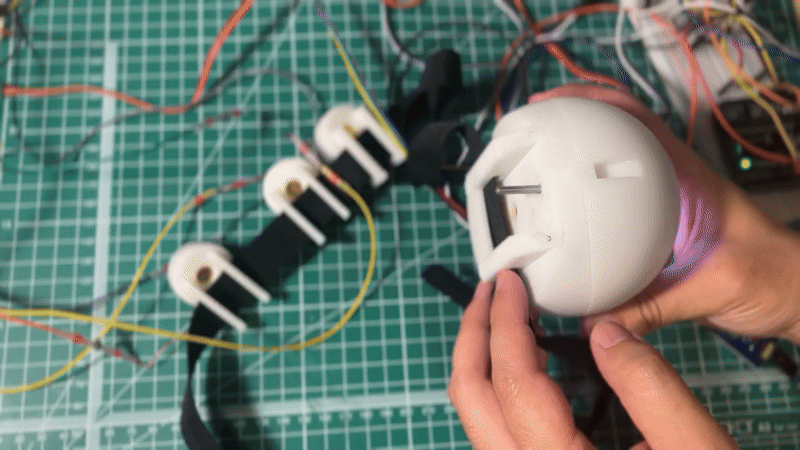
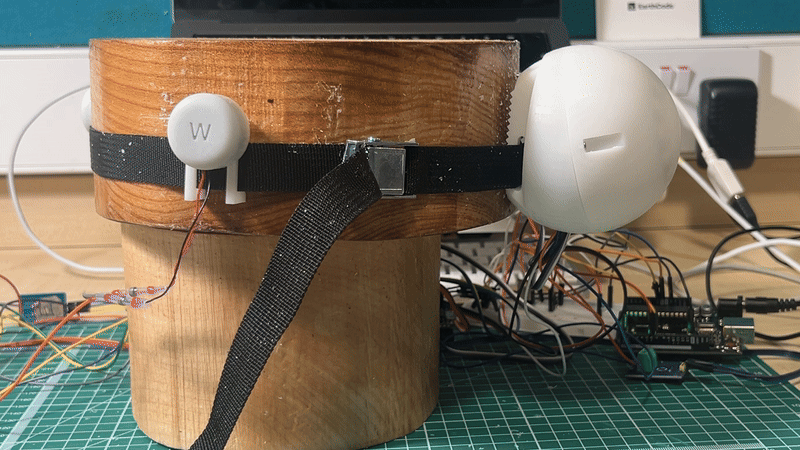
TreeNoc has been trialled on logs from multiple species, distinguishing each vibration signature, while an onboard LED gives in‑situ cues—glowing steady when operating and flashing if anomalies arise.
10. Do you really need a band on every tree?
City budgets will be crushed if thousands of units have to be installed, so TreeNoc borrows a well‑tested forestry idea: the sentinel. A few carefully chosen “indicator” stems can speak for the whole stand when they share soil type, micro‑climate and species mix. Long‑term studies show that 15–30 trees per hectare capture > 90 % of structural and pest trends detected by full inventories, and urban biosecurity networks already rely on sentinel trees to warn of invasive insects before outbreaks spread.
1) Cluster selection – GIS layers and street records group trees into homogeneous blocks (same species, age class, soil). One vigorous, average‑sized stem per ~25 neighbours becomes the Sentinel ID.
2) Band deployment – the TreeNoc belt is fitted only to those IDs; installation density equals roughly one unit every 20–30 m along a typical London boulevard, or one per 0.1 ha in mixed parks.
3) Data extrapolation – algorithms compare each sentinel’s echo, moisture and growth curve with historical baselines; if the risk score jumps, caretakers know its cluster needs inspection. In trials, this rule cut manual site visits by 65 % while missing < 5 % of genuine hazards compared with 100 % coverage
How the sentinel model works
1) Cluster selection – GIS layers and street records group trees into homogeneous blocks (same species, age class, soil). One vigorous, average‑sized stem per ~25 neighbours becomes the Sentinel ID.
2) Band deployment – the TreeNoc belt is fitted only to those IDs; installation density equals roughly one unit every 20–30 m along a typical London boulevard, or one per 0.1 ha in mixed parks.
3) Data extrapolation – algorithms compare each sentinel’s echo, moisture and growth curve with historical baselines; if the risk score jumps, caretakers know its cluster needs inspection. In trials, this rule cut manual site visits by 65 % while missing < 5 % of genuine hazards compared with 100 % coverage
11. Significance and Applications
TreeNoc represents the first “always-on” tree tomography ring—a continuous monitoring system that can be left on a tree to automate health inspections. Its four small pods can be installed around a trunk in about five minutes, and once in place they self-calibrate and begin their knock-and-listen routine without needing human intervention. The system is designed to run for years, periodically sending out tiny data packets that report only changes from the norm. This approach means that instead of overwhelming tree managers with raw numbers, TreeNoc provides a clear trend over time, highlighting only when and where the tree’s internal condition is changing.
![]()
This technology fills a crucial gap in tree care and urban forest management. Until now, monitoring tree health relied largely on external observation or occasional check-ups with expensive tools. Drones, satellite images, or street-level cameras can tell if a tree has a full canopy of leaves, but they cannot see inside the trunk. Often a tree can appear perfectly healthy externally even while it is hollow or rotting inside—a dangerous situation that might not be discovered until the tree falls. Meanwhile, manual inspections by skilled arborists (like climbing the tree or drilling into it for samples) are time-consuming and cannot be done frequently on every tree.
TreeNoc offers a smart alternative by continuously watching for the subtle internal signs of trouble. It alerts caretakers to issues long before a tree reaches the point of collapse, enabling preventative actions. By tracking the tree’s “heartbeat” in terms of structural soundness and growth patterns, TreeNoc helps cities and caretakers keep their trees safer and healthier in a proactive way.
This technology fills a crucial gap in tree care and urban forest management. Until now, monitoring tree health relied largely on external observation or occasional check-ups with expensive tools. Drones, satellite images, or street-level cameras can tell if a tree has a full canopy of leaves, but they cannot see inside the trunk. Often a tree can appear perfectly healthy externally even while it is hollow or rotting inside—a dangerous situation that might not be discovered until the tree falls. Meanwhile, manual inspections by skilled arborists (like climbing the tree or drilling into it for samples) are time-consuming and cannot be done frequently on every tree.
TreeNoc offers a smart alternative by continuously watching for the subtle internal signs of trouble. It alerts caretakers to issues long before a tree reaches the point of collapse, enabling preventative actions. By tracking the tree’s “heartbeat” in terms of structural soundness and growth patterns, TreeNoc helps cities and caretakers keep their trees safer and healthier in a proactive way.
